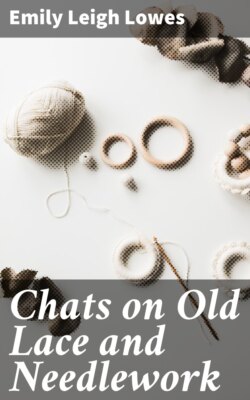Читать книгу Chats on Old Lace and Needlework - Emily Leigh Lowes - Страница 4
На сайте Литреса книга снята с продажи.
ОглавлениеORIGINAL PATTERNS DESIGNED BY VINCIOLA. Seventeenth Century.
A little later, but still contemporary with the introduction of Venetian lace, a Pillow lace was being made in Flanders, the origin of which is not as yet discovered. It is possible that the fine flax thread grown and manufactured there may, at the time of weaving, have suggested a looser and more ornamental material, but that remains a matter of conjecture. There must, however, have been an interchange of examples, as about this time Pillow-made lace appeared in Italy, and led to the making of the Milanese and Genoese varieties, and Needlepoint motifs appeared amongst the woven network of Flanders.
Lace, under the name of "Lacis," had been known in France from the time of Catherine de Medici, who patronised the manufacturers and used it lavishly. About 1585 she induced Federico di Vinciolo, a lace-maker and designer of Venice, to settle in France, and there the making of Venetian lace was attempted. A mere slavish imitation of the Venetian school resulted, and it was not until the age of the Grande Monarque, Louis XIV., that French lace rivalled that of Venice.
Colbert, the great French Minister, becoming alarmed at the enormous sums spent on Italian lace, determined to put a check to its importation; and, by forbidding its use, establishing lace schools near Alençon, and bribing Italian workers to come over as organisers and teachers, started the manufacture of lace on an extensive scale, the beautiful fabrics known as Point d'Alençon, Point d'Argentan, and Point d'Argentella being the result. It is frequently said that the last-named lace came from Genoa or Milan, but most of the present-day authorities agree that this is one of the many fairy tales with which the passing of time has adorned the history of lace.
The persecution of the Protestants when the Huguenots fled to England, bringing with them their arts of silk-weaving and lace-making, led to the introduction of English lace. Devonshire apparently received a contingent of laceworkers quite distinct from those who settled in Buckinghamshire and Bedfordshire, and from the first stages showed far finer methods and designs. With the exception of "Old Honiton," England cannot boast of anything very fine, and even this is merely a meaningless meandering of woven tape-like design for the greater part. The lace of Buckinghamshire ranks, perhaps, lowest in the scale of lace products, its only merit being its extreme durability.
The laces of Ireland are of comparatively recent growth, and though in many instances exquisitely fine, do not as yet show much originality.
ORIGINAL PATTERNS DESIGNED BY VINCIOLA.
